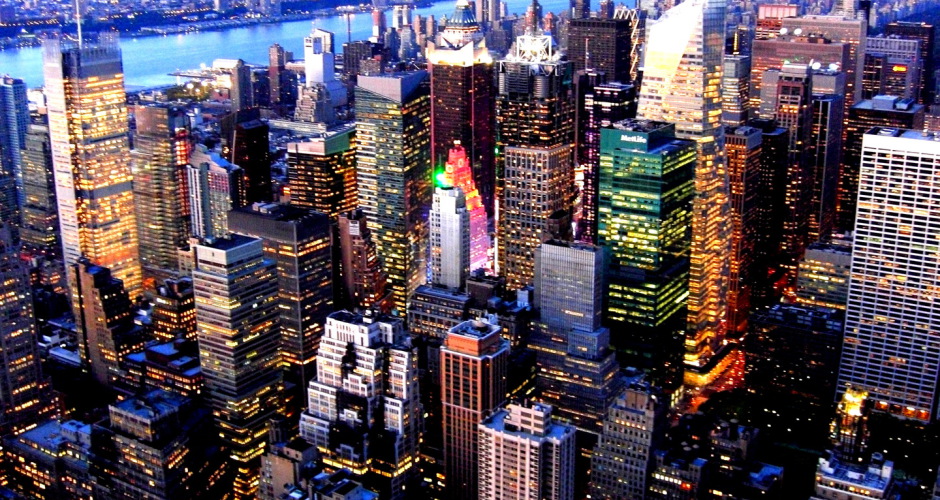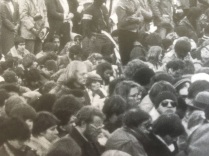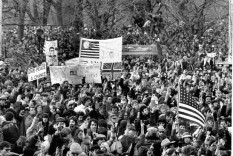
Sunday, December 14, 1980
Noon: Stopped by the Dakota. Very eerie. Dark, Victorian building in shadows. Large crowd gathered outside, blocking intersection of 72nd and Central Park West. Police blockade around entrance. Occasionally, a resident would look out at the crowd. Yoko and Sean inside facing the park, I’m told.
Radios playing. People silent, staring. Many crying. Vultures selling buttons, t-shirts.
Walkway extends right from 72nd Street into Central Park. Short walk to the bandshell. Arrive about 12:15. Lots of people already there, but still enough room to get within five rows of the front-line police barriers. Helicopters fly overhead. NBC, ABC, CBS, BBC cameras are on a flatbed truck nearby. Photographers everywhere.
Wreaths and flowers are placed around the shell by workmen. About 1:00 PM, an easel is put up in front of the shell. Huge photo of John is put on easel. Wearing sunglasses and “New York City” t-shirt. Good choice. Rather cocky pose. Large flower arrangements come in. Later, worker brings in guitar-shaped arrangement á la Sgt. Pepper cover. Places it on ground in front of easel.
Huge stacks of speakers begin broadcasting classical piano music, then the Brandenburg Concertos.
Striking images: Facing Lennon photo from back of the amphitheater is a bust of Beethoven (Lennon’s been called the Beethoven of our times). Someone in crowd has a photo of Lennon on a makeshift pole. Holds it up, not realizing that from some vantage points, it appears to be “crucified” on a t-shaped light pole in background. Lennon would have appreciated that ("The way things are going, they're going to crucify me"). Someone else has an American flag sewn to a British flag.
Mayor Ed Koch walks into bandshell area with a small entourage. Does nothing of note, walks out five minutes later.
At 1:30, PA broadcasts Lennon music. “In My Life” begins. Perfect. The most beautiful love song ever written. Choking back tears. “You’ve Got to Hide Your Love Away” follows.
“All You Need is Love” gets crowd on feet, singing, flashing peace signs. A real feeling the spirit lives on.
“Julia” is next. Then one from early Plastic Ono Band.
From “Double Fantasy”: “Watching the Wheels.” Every song receives subdued applause.
At 40 seconds before 2:00 disembodied announcer requests that everyone get comfortable, remain silent per Yoko’s wishes. Front six rows, previously sitting uncomfortably, cramped, stand again.
Ten minutes. Total silence in a crowd of 100,000. A lot of birds suddenly appear overhead. Helicopters continue to fly in wide circle.
At the end of ten minutes, no announcement is made. Suddenly, the opening chords of “Imagine” are heard. Again, perfect. He was a dreamer. The sound of those chords alone was more than most could take. Tears flow freely.
One helicopter drops a “bouquet” of white balloons.
“Give Peace a Chance” follows. Impassioned sing-along, with peace signs again flashing.
Crowd was mixed. Children to seniors. Communists in army fatigues. Even Jane Fonda and Tom Hayden, they say. People holding photos, holding candles, holding each other.
Classical music comes on again, mixed, inappropriately, with Peter Nero-esque piano versions of McCartney’s “Hey Jude” and “Yesterday” (John didn’t believe in yesterdays). Then, perhaps because of cries for “Play some more Lennon,” the tunes from the 1:30 set were repeated.
The crowd, up front at least, does not move. Not even a sign of motion. Still silent. After 30 minutes, announcer hints that we should leave in “an orderly manner.” Still, no one moves. Five minutes later, a stronger hint: “Please leave in an orderly manner. Thank you for sharing this tribute.” No movement. After about ten more minutes, Lennon photo is removed. No movement. Three minutes later, it is returned. Cheers.
People hand flowers to workmen, who place them under the easel.
Crowd from the back, who could not see much of the “altar” starts to move toward the front for a better look. Pushing begins. Announcer asks that we stay peaceful, “as John would have wanted it.” It’s now about 3:00 and many in front, including myself, decide we should make room for those from the back. Goodbye, John.
Walk back past the Dakota. Crowd there has more than doubled. After a last look, head for train station. On 71st Street, a resident is playing Lennon music through an open window. The street is filled with people.
On way to train station, pass record store with framed photo of Lennon from the White Album. A single rose sits in front of it.
One last note: One of the last songs heard at the “vigil” was Harrison’s “All Things Must Pass.” “Daylight is good at arriving at the right time/It’s not always going to be this gray.”
Maybe not. But it’ll never again be quite as bright.
Bill Kozel


